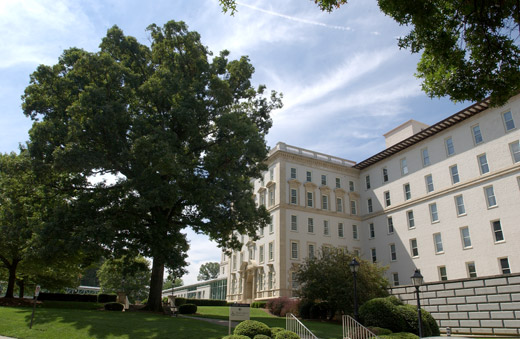Campus News
September 12, 2011
Rooted in history, Calhoun Oak comes down

The giant white oak in front of Emory University Hospital was taken down, after succumbing to Ambrosia beetles.
By Leslie King
A giant white oak tree that has sheltered the grounds of Emory University Hospital for over a century has come to the end of its life.
Known as the Calhoun Oak after an Emory doctor who saved it from an untimely end in the 1940s, the tree was taken down over the weekend of Sept. 10.
The tree had succumbed to an invasion of Ambrosia beetles, "a very devilish pest since it generally strikes healthy trees," which the Calhoun Oak was, says Jimmy Powell, director of engineering and exterior services.
"Once symptoms of [the beetles'] presence appear, it is often too late. Thousands of oaks and hickories in Atlanta have succumbed to the Ambrosia beetle over the last decade."
Vice President and Deputy to the President Gary Hauk, an Emory historian, says, "Old trees like the Calhoun Oak can sometimes stir the imagination — the tree was growing on that spot before Clifton Road was even paved! So it's poignant when we lose this kind of real, physical connection to an earlier age and its people."
Rooted in history
During the mid-1940s when the hospital expanded, construction called for cutting down a number of big trees, including the white oak.
The trees had an advocate in F. Phinizy Calhoun, who had recently retired as chairman of the Department of Opthalmology after three decades. Calhoun pleaded the case before the Board of Trustees and hospital officials and won.
In 1964, when Calhoun was in his 80s, the great white oak was dedicated in his honor because of his special fondness for the tree and his interest in campus beautification. A brass plaque, noting Calhoun's contribution, was affixed to the tree.
The plaque is now in the safekeeping of David Woolf, senior director of development of the Emory Eye Center.
Woolf says the plan is to preserve pieces of the tree, mount the plaque on one and present them to the Calhoun family, whose members have a history entwined with Emory for over a century.
Powell also says some pieces of wood suitable for wood turning will be saved. The main trunk, if free of decay, will be cut into a length of 7 to 8 feet. A portable sawmill will cut some solid slabs 7 feet long with a width roughly the diameter of the trunk. These slabs will be kiln dried and ready for use in about nine months, he added.
Powell had said earlier the Calhoun Oak's exact age isn't known, but "we'll know its age after it comes down. We'll count the rings."
The oak had been monitored closely by Campus Services and arbor vendors throughout its life, appropriately pruned and fertilized. It was initially going to be removed during the coming winter. But recent severe weather moved up the plan.
Trees to be replanted
Later this winter, Emory will transplant one of the trees in front of The Emory Clinic Building B to the same spot where the Calhoun oak stood. The trees will have to be removed for Emory University Hospital's new bed tower, says Powell.
"There are several oaks in this area that have been planted in the last 10 years and these trees are quite large, yet small enough to still be moved by carefully digging and transporting the tree and root ball to a new site across the street."
Powell says trees in the 20-foot-high range with 10-12 inch diameters are candidates.
"We're calling [the tree that will be re-planted] CO2," he laughs.
Referencing a successful tree re-planting 10 years ago, Powell says, "You may remember we moved similar sized oaks from the Whitehead Memorial Biomedical Building site prior to its construction. These three Shumard oaks are thriving today in the grove of trees between the Goizueta Business School and the Schwartz Center."
He notes these should give an idea of what the newcomer to the hospital's grove will be like in 10 years.
